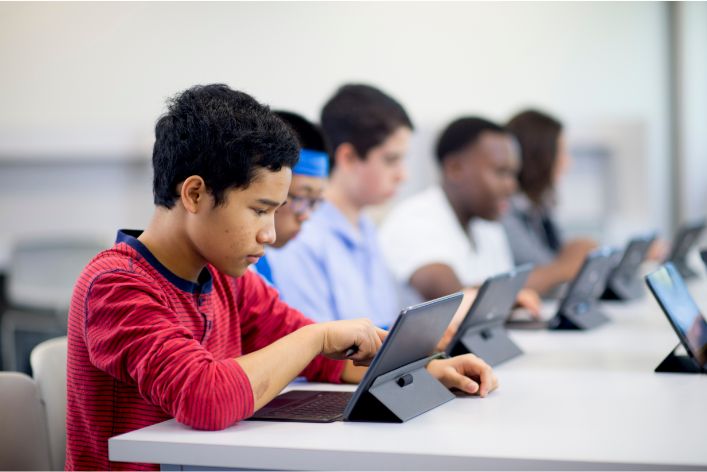Introduction
Digital education has evolved rapidly in recent years.
Over 1.2 billion children worldwide have faced school closures due to COVID-19, highlighting the urgent need for robust digital learning solutions.
This unprecedented shift has accelerated the adoption of online education, revealing both its potential and its challenges.
Now, as we stand on the brink of the 5G era, it’s crucial to understand how this technology can further revolutionize digital education.
The Promise of 5G Technology
5G technology promises to transform digital education by offering:
- Faster Internet Speeds: 5G provides speeds up to 100 times faster than 4G.
- Lower Latency: It reduces latency to as low as 1 millisecond.
- Increased Capacity: 5G can support up to a million devices per square kilometer.
These features can address many current limitations of digital education.
Current State of 5G Deployment
5G is gradually rolling out worldwide.
Major cities in the U.S., China, South Korea, and Europe already have 5G coverage.
However, rural areas and developing countries are still catching up.
Despite this, the global expansion of 5G is inevitable and progressing rapidly.
Impact on Digital Education
5G will enhance digital education in several ways:
- Improved Connectivity: Students and educators will experience fewer disruptions and faster access to resources.
- Real-Time Interactivity: Lower latency will enable seamless real-time communication and collaboration.
- Advanced Technologies: 5G will support immersive technologies like virtual reality (VR) and augmented reality (AR), offering interactive and engaging learning experiences.
- Personalized Learning: Enhanced AI capabilities will enable tailored educational experiences based on individual needs.
As 5G continues to expand, its impact on digital education will grow, making learning more accessible, engaging, and effective.
The future of digital education is bright with 5G technology.
By addressing current challenges and introducing innovative solutions, 5G will play a pivotal role in shaping the next generation of learning.
Stay tuned as we explore this exciting transformation in greater detail throughout this blog post.
Section 1: Understanding 5G Technology
Definition and Key Features
5G stands for the fifth generation of mobile network technology.
It represents a significant leap forward from previous generations.
Unlike 4G, which primarily enhanced mobile broadband, 5G aims to revolutionize connectivity across various sectors.
5G technology boasts three primary features:
- Higher Speeds: 5G offers data transfer rates up to 10 Gbps, vastly outpacing 4G.
- Lower Latency: Latency drops to as low as 1 millisecond, compared to 50 milliseconds with 4G.
- Increased Capacity: 5G supports up to one million devices per square kilometer, a huge increase from 4G.
These features enable 5G to handle more data, connect more devices, and offer faster, more reliable connections.
Higher Speeds
5G’s higher speeds make downloading and uploading data incredibly fast.
This means high-definition videos and large files can be transferred almost instantaneously.
For digital education, this speed ensures smooth streaming of video lectures and quick access to online resources.
Lower Latency
Low latency is crucial for real-time interactions.
With 5G, the delay between sending and receiving information is almost negligible.
This feature is vital for interactive applications, such as virtual classrooms and online exams, ensuring a seamless user experience.
Increased Capacity
5G’s increased capacity allows it to support a massive number of devices simultaneously.
This is essential in educational environments where many students and teachers use multiple devices.
It ensures stable connections without slowdowns, even during peak usage times.
Comparison with Previous Generations
To understand 5G’s impact, it helps to compare it with earlier generations.
Each generation of mobile technology has brought significant advancements.
3G Technology:
- Speeds: 3G offered data rates up to 2 Mbps.
- Latency: Latency in 3G networks was around 100 milliseconds.
- Capacity: 3G could support fewer devices and had limited data handling capabilities.
4G Technology:
- Speeds: 4G significantly improved speeds to up to 100 Mbps.
- Latency: Latency decreased to around 50 milliseconds.
- Capacity: 4G could support more devices and better data handling than 3G.
5G Technology:
- Speeds: 5G offers speeds up to 10 Gbps, a hundredfold increase from 4G.
- Latency: Latency in 5G networks can be as low as 1 millisecond.
- Capacity: 5G supports up to one million devices per square kilometer.
This comparison highlights the dramatic improvements 5G brings over 3G and 4G.
Real-World Applications
The real-world applications of 5G are vast and varied.
In digital education, 5G enables advanced technologies that enhance learning experiences.
These include virtual reality (VR), augmented reality (AR), and artificial intelligence (AI).
These technologies require high-speed, low-latency connections to function effectively.
We Design & Develop Websites, Android & iOS Apps
Looking to transform your digital presence? We specialize in creating stunning websites and powerful mobile apps for Android and iOS. Let us bring your vision to life with innovative, tailored solutions!
Get Started TodayVirtual Reality (VR) and Augmented Reality (AR):
- VR: 5G allows immersive VR experiences without lag, enhancing interactive learning.
- AR: 5G enables real-time AR applications, enriching the learning environment with interactive content.
Artificial Intelligence (AI):
- AI in Education: 5G supports AI-driven personalized learning experiences, adapting to each student’s needs.
Understanding 5G technology is crucial to grasp its potential impact on digital education.
With higher speeds, lower latency, and increased capacity, 5G promises to revolutionize how we connect and learn.
By comparing it with previous generations, we see the significant advancements 5G brings.
These advancements will enable innovative applications that enhance and transform the educational experience.
As 5G technology continues to roll out, its influence on digital education will become increasingly profound.

Section 2: Current State of Digital Education
Overview of Digital Education
Digital education has transformed how students learn and interact with educational content.
The current landscape includes a variety of innovative technologies and platforms.
Key Technologies and Platforms:
- Massive Open Online Courses (MOOCs):
- Platforms like Coursera and edX offer courses from top universities to millions of learners worldwide.
- Platforms like Coursera and edX offer courses from top universities to millions of learners worldwide.
- Virtual Classrooms:
- Tools like Zoom and Google Classroom facilitate real-time interactions between students and teachers, mimicking traditional classrooms.
- Tools like Zoom and Google Classroom facilitate real-time interactions between students and teachers, mimicking traditional classrooms.
- Educational Apps:
- Apps like Duolingo and Khan Academy provide interactive and personalized learning experiences.
- Apps like Duolingo and Khan Academy provide interactive and personalized learning experiences.
- Learning Management Systems (LMS):
- Platforms like Moodle and Blackboard help manage, deliver, and track learning processes efficiently.
These technologies make education more accessible and flexible, catering to diverse learning needs and styles.
Challenges in Digital Education
Despite its benefits, digital education faces several significant challenges.
These issues hinder its effectiveness and limit its reach.
Connectivity Issues:
- Internet Access: Many students lack reliable internet access, particularly in rural and underserved areas.
- Bandwidth Limitations: Slow internet speeds can disrupt online learning, making it difficult to stream videos or participate in virtual classes.
Latency Problems:
- Delay in Communication: High latency can cause delays in communication, leading to a less interactive and engaging learning experience.
- Real-Time Interaction: Effective real-time interaction, crucial for virtual classrooms and online discussions, suffers due to latency issues.
Limited Interactivity:
- Lack of Hands-On Learning: Digital education often lacks practical, hands-on learning experiences, which are essential in fields like science and engineering.
- Engagement Challenges: Maintaining student engagement is challenging without the face-to-face interaction of traditional classrooms.
Digital Divide:
- Socioeconomic Barriers: Students from low-income families often lack access to necessary devices and internet, widening the educational gap.
- Geographic Disparities: Students in remote or rural areas face greater challenges accessing digital education resources.
Teacher Preparedness:
- Training: Many educators lack the training needed to effectively use digital tools and platforms.
- Adapting to Technology: Adapting traditional teaching methods to digital formats can be challenging for teachers.
Content Quality and Relevance:
- Standardization: Ensuring consistent and high-quality content across different platforms and courses is a major challenge.
- Up-to-Date Material: Keeping educational content current and relevant in a rapidly changing world is essential but difficult.
Security and Privacy Concerns:
- Data Security: Protecting student data and ensuring secure online environments is a critical issue.
- Privacy: Maintaining privacy in digital classrooms and managing consent for data use are ongoing concerns.
Assessment and Feedback:
- Evaluation Methods: Traditional assessment methods may not be effective in digital education.
- Timely Feedback: Providing timely and meaningful feedback in an online environment is challenging.
Digital education has brought remarkable changes to how we learn and teach.
Technologies like MOOCs, virtual classrooms, and educational apps make learning more accessible and flexible.
However, significant challenges remain, including connectivity issues, latency problems, and limited interactivity.
Overcoming these challenges is crucial to realizing the full potential of digital education.
As 5G technology continues to roll out, it promises to address many of these issues, paving the way for a more connected, interactive, and inclusive educational landscape.
Read: The Role of Teachers in Modern Education: Adapting to Changing Student Needs
Section 3: How 5G Technology Will Transform Digital Education
Enhanced Connectivity
5G technology will provide faster and more reliable internet connections.
It offers speeds up to 10 Gbps, significantly faster than 4G.
This enhanced connectivity will have a profound impact on remote learning.
Impacts on Remote Learning:
- Seamless Video Streaming: Students can stream high-definition video lectures without buffering.
- Quick Downloads: Educational resources, like e-books and software, will download almost instantly.
- Stable Connections: More reliable connections will reduce disruptions during online classes.
Improved connectivity will make digital education more accessible and effective, especially for remote learners.
Improved Real-Time Interactivity
Low latency is crucial for real-time interactions in digital education.
5G reduces latency to as low as 1 millisecond, enabling near-instantaneous communication.
Applications in Education:
- Live Streaming of Lectures: Teachers can stream lectures live with minimal delay, enhancing engagement.
- Virtual Labs: Students can perform experiments in virtual labs, interacting with simulations in real-time.
- Real-Time Feedback: Teachers can provide immediate feedback during online assessments, improving learning outcomes.
Low latency will create a more interactive and engaging learning environment.
Virtual and Augmented Reality
5G can support advanced VR and AR applications in education.
These technologies require high-speed, low-latency connections, which 5G provides.
Examples of Immersive Learning Experiences:
- Virtual Field Trips: Students can explore historical sites or outer space through VR, experiencing places they couldn’t visit physically.
- AR in Classrooms: AR can overlay digital information on physical objects, making complex subjects like anatomy or chemistry more understandable.
- Interactive Simulations: VR can simulate real-world scenarios for subjects like history or engineering, providing hands-on learning experiences.
These immersive experiences will make learning more engaging and effective.
AI and Personalized Learning
5G will facilitate the use of AI in education.
AI can analyze vast amounts of data quickly, providing personalized learning experiences.
Potential for Personalized Learning:
- Adaptive Learning Platforms: AI can tailor lessons to individual students’ needs, pacing, and learning styles.
- Smart Tutoring Systems: AI tutors can provide personalized assistance, helping students understand difficult concepts.
- Predictive Analytics: AI can predict student performance and identify those at risk of falling behind, allowing for timely interventions.
Personalized learning experiences will help each student reach their full potential.
Global Collaboration
5G will enable seamless global collaboration between students and educators.
It will facilitate real-time communication and cooperation across borders.
Potential for International Projects:
- Global Classrooms: Students from different countries can participate in joint classes, sharing diverse perspectives.
- Cross-Cultural Exchanges: 5G can support live cultural exchange programs, enhancing understanding and cooperation.
- International Research Projects: Researchers can collaborate in real-time, sharing data and findings instantly.
Global collaboration will enrich the educational experience and prepare students for a connected world.
5G technology will transform digital education by enhancing connectivity, enabling real-time interactivity, and supporting advanced technologies like VR, AR, and AI.
It will provide personalized learning experiences and facilitate global collaboration.
These advancements will make education more accessible, engaging, and effective, paving the way for a brighter future.
We Design & Develop Websites, Android & iOS Apps
Looking to transform your digital presence? We specialize in creating stunning websites and powerful mobile apps for Android and iOS. Let us bring your vision to life with innovative, tailored solutions!
Get Started TodayAs 5G continues to roll out, its impact on education will only grow, revolutionizing how we learn and teach.
Read: AI Tools Revolutionizing Modern Education: Top 10 in 2024
Section 4: Case Studies and Examples
Case Study 1: University of Oulu
The University of Oulu in Finland has successfully implemented 5G technology across its campus.
This university is a pioneer in leveraging 5G for educational purposes.
Implementation Details:
- 5G Network Installation: The university installed a 5G network across its campus.
- Enhanced Digital Infrastructure: It upgraded its digital infrastructure to support 5G applications and services.
Benefits and Improvements Observed:
- Seamless Connectivity: Students and faculty experience seamless internet connectivity, enhancing their online learning experiences.
- Real-Time Interactivity: Low latency enables real-time interactions during virtual classes, increasing student engagement and participation.
- Virtual Reality Integration: The university introduced VR labs, allowing students to engage in immersive learning experiences.
- Remote Learning: The reliable 5G network supports remote learning, ensuring students can attend classes from anywhere without connectivity issues.
Specific Examples:
- Virtual Labs: Science students use VR labs to conduct experiments, providing hands-on learning experiences without physical lab constraints.
- Remote Access: Students from rural areas can access high-quality education, bridging the digital divide.
The University of Oulu’s implementation of 5G has significantly improved the quality of education and student engagement.
Case Study 2: Curiosity Lab
Curiosity Lab, an innovative educational startup, leverages 5G technology to deliver cutting-edge learning solutions.
This startup focuses on providing interactive and personalized learning experiences.
Innovative Solutions:
- AI-Powered Tutoring: Curiosity Lab uses AI to provide personalized tutoring based on individual student needs.
- VR and AR Learning: It integrates VR and AR to create immersive and engaging educational content.
- Real-Time Feedback: The platform offers real-time feedback to students, enhancing their learning process.
Outcomes and Impact on Students:
- Enhanced Learning: Students show improved understanding and retention of complex concepts due to interactive and immersive learning experiences.
- Personalized Education: AI-driven personalization helps tailor lessons to individual learning styles and paces, improving student performance.
- Increased Engagement: The use of VR and AR keeps students engaged and motivated, reducing dropout rates.
Specific Examples:
- Immersive History Lessons: Students explore historical events through VR, experiencing them firsthand, which enhances their understanding and interest in the subject.
- Interactive Science Experiments: AR allows students to visualize and interact with scientific phenomena, making learning more intuitive and exciting.
Curiosity Lab’s innovative use of 5G technology demonstrates the potential for startups to revolutionize education with personalized and interactive learning solutions.
These case studies illustrate the transformative impact of 5G technology on education.
The University of Oulu’s successful implementation highlights the benefits of enhanced connectivity and real-time interactivity.
Curiosity Lab’s innovative approach showcases how startups can leverage 5G to deliver cutting-edge learning experiences.
As 5G continues to expand, we can expect more educational institutions and startups to adopt this technology, further revolutionizing digital education.
The future of education is bright with 5G, promising more engaging, accessible, and personalized learning experiences for all students.
Read: How VR is Transforming Online Learning for Students

Section 5: Challenges and Considerations
Infrastructure and Deployment
Deploying 5G infrastructure presents significant challenges.
Building a 5G network requires extensive and costly infrastructure upgrades.
Challenges:
- Geographical Disparities: Urban areas see faster deployment, while rural regions lag behind due to higher costs and logistical challenges.
- Economic Disparities: Wealthier countries can afford rapid 5G deployment, whereas developing nations struggle with limited resources and funding.
- Physical Infrastructure: Installing numerous small cell towers and fiber-optic cables is labor-intensive and time-consuming.
These challenges create uneven access to 5G technology, affecting its potential impact on digital education.
Privacy and Security
5G-enabled educational environments raise important privacy and security concerns.
Enhanced connectivity increases the risk of data breaches and cyberattacks.
Concerns:
- Data Privacy: Increased data flow means more personal information is at risk of being exposed or misused.
- Cybersecurity: Educational institutions must protect against sophisticated cyber threats targeting sensitive student and staff data.
- Regulatory Compliance: Schools and universities need to comply with strict data protection regulations, adding to their administrative burden.
Ensuring robust privacy and security measures is crucial for maintaining trust in 5G-enabled educational systems.
Cost and Accessibility
The cost of implementing 5G technology poses significant challenges for educational institutions and students.
Cost Implications:
- Infrastructure Investment: Schools need to invest heavily in 5G infrastructure, including network upgrades and new devices.
- Maintenance Costs: Ongoing maintenance and upgrades add to the financial burden.
- Device Costs: Students and educators need 5G-compatible devices, which can be expensive.
Ensuring Equitable Access:
- Subsidies and Grants: Governments and organizations should provide subsidies and grants to help schools afford 5G infrastructure.
- Public-Private Partnerships: Collaborations between public entities and private companies can fund 5G deployment in underfunded areas.
- Affordable Devices: Manufacturers should offer affordable 5G devices to ensure that all students can access digital education.
Addressing these cost and accessibility issues is essential for maximizing the benefits of 5G in education.
Overcoming Digital Divide
5G technology has the potential to bridge the digital divide, but only if deployment is equitable.
Strategies to Overcome the Digital Divide:
- Government Initiatives: Governments must prioritize 5G deployment in rural and underserved areas.
- Community Programs: Local programs can provide digital literacy training and access to 5G technology.
- Educational Partnerships: Partnerships between educational institutions can share resources and expertise to ensure wider access.
Equitable deployment of 5G will ensure that all students benefit from enhanced digital education.
The challenges and considerations surrounding 5G technology are significant but not insurmountable.
Deploying 5G infrastructure requires addressing geographical and economic disparities.
Ensuring data privacy and cybersecurity is crucial in a 5G-enabled educational environment.
Addressing the cost implications and ensuring equitable access to 5G technology are essential for maximizing its benefits.
By overcoming these challenges, we can fully realize the transformative potential of 5G in digital education.
This will lead to a more connected, secure, and accessible educational landscape for students and educators worldwide.
As we move forward, collaborative efforts will be key to navigating these challenges and unlocking the full potential of 5G technology in education.
Read: Educational Apps for Personalized Learning Experiences: Best Picks
Conclusion
Recap of Key Points
5G technology promises to revolutionize digital education with faster speeds, lower latency, and increased capacity.
We explored how 5G enhances connectivity, improving remote learning and access to educational resources.
The technology’s low latency supports real-time interactions, such as live streaming lectures and virtual labs.
We Design & Develop Websites, Android & iOS Apps
Looking to transform your digital presence? We specialize in creating stunning websites and powerful mobile apps for Android and iOS. Let us bring your vision to life with innovative, tailored solutions!
Get Started TodayAdvanced VR and AR applications will create immersive learning experiences, while AI will enable personalized learning tailored to individual student needs.
Additionally, 5G will facilitate seamless global collaboration among students and educators.
We also examined real-world case studies.
The University of Oulu and Curiosity Lab demonstrate how 5G can transform educational environments.
Both institutions highlighted significant improvements in engagement, accessibility, and overall educational quality.
Future Outlook
The continued evolution of 5G will have a profound long-term impact on digital education.
As 5G technology becomes more widespread, we can expect even more innovative applications to emerge.
Schools and universities will integrate 5G into their infrastructure, making digital education more interactive and effective.
Future advancements may include even more sophisticated AI-driven personalized learning, further reducing the digital divide and ensuring equitable access to quality education.
Call to Action
Stay informed about 5G developments and consider how to leverage this technology in your educational context.
Explore the latest 5G-enabled tools and platforms that can enhance your learning or teaching experience.
Educators should seek training on 5G applications to maximize their benefits.
Policymakers and educational institutions must prioritize investments in 5G infrastructure and address challenges like connectivity, privacy, and cost.
By embracing 5G technology, we can collectively create a more connected, inclusive, and innovative educational landscape.
The future of digital education is bright, and 5G technology will play a pivotal role in shaping it.
Stay engaged with the latest trends and be proactive in integrating 5G into your educational endeavors.
Together, we can transform education for the better.
Additional Resources
For Further Reading:
- 5G in Universities: Enabling Near Limitless Learning
- Bridging The Digital Divide In Higher Education
- How AI and 5G will power the next wave of Innovation
Before You Go…
Hey, thank you for reading this blog post to the end. I hope it was helpful. Let me tell you a little bit about Nicholas Idoko Technologies.
We help businesses and companies build an online presence by developing web, mobile, desktop, and blockchain applications.
We also help aspiring software developers and programmers learn the skills they need to have a successful career.
Take your first step to becoming a programming expert by joining our Learn To Code academy today!
Be sure to contact us if you need more information or have any questions! We are readily available.
Put Your Tech Company on the Map!
Get featured on Nicholas Idoko’s Blog for just $200. Showcase your business, boost credibility, and reach a growing audience eager for tech solutions.
Publish Now










